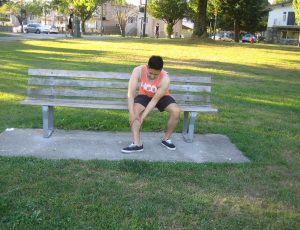Achilles tendonitis is a condition where the Achilles tendon is inflamed and triggers pain. This condition is caused by overusing the tendon especially when exerting significant stress on the tendon without proper building-up of strength.
[youtube url=”https://www.youtube.com/watch?v=zzzTsMo5rgQ”]The Achilles tendon is connected to the calf muscles of the heel bone or calcaneus. The tendons are used for jumping, walking, running and standing on the balls of the feet. Continuous performing of these activities can cause a severe painful inflammation of the Achilles tendon.
Causes of Achilles tendonitis
- Excessively performing in exercises or walking especially among athletes.
- Suffering from rheumatoid arthritits
- Performing exercises without proper warm-up exercises
- Wearing old or poorly-fitting shoes

Pain and swelling in the posterior area of the heel when walking and running. - Straining the calf muscles when performing repeated exercises or other physical activities
- Playing sports such as tennis that requires quick stops and changing directions
- Regularly wearing high heels for long periods of time
Symptoms
- Pain and swelling in the posterior area of the heel when walking and running.
- Limited range of motion when flexing the foot
- Tight calf muscles
- The affected skin is warm to the touch
Treatment
- Take plenty of rest especially the affected tendon. Avoid running, climbing stairs and engaging in high-impact activities that can strain on the tendon.
- While resting the tendon, perform gentle exercises such as biking, elliptical exercises and swimming.
- Apply an ice pack on the affected area to lessen the swelling and pain. Wrap the ice pack in a towel and place on the affected area for at least 15 minutes several times throughout the day until pain is reduced.
- After performing an exercise, apply an ice pack on the area to prevent pain and inflammation.
- Take over-the-counter pain medications such as acetaminophen or non-steroidal anti-inflammatory drugs (NSAIDs) such as ibuprofen or naproxen to lessen the pain and swelling caused by Achilles tendonitis.
- Wrap the foot and the lower leg using an elastic bandage or compression wrap to minimize the swelling and unnecessary movement of the affected tendon.
- Elevate the foot above the level of the heart to lessen the swelling. When sleeping, keep the foot elevated by placing a couple of pillows under the legs.
- Stop smoking and using other tobacco products. Smoking slows down the healing process and the repair of tissues in the area.
- Wear footwear that cushions the arches and heels to lessen the pain and promote fast healing of the condition. Shoes that are soft at the back of the heel will lessen the pain.
- Use orthotic devices that are inserted into the footwear.
- If the pain is severe, wear the prescribed recovery boot to make the foot flexed and prevent straining of the tendon. Avoid prolonged use of the recovery boot to prevent weakening of the calf muscles.
- Seek the help of the physical therapist for some rehabilitation and strengthening exercises.
